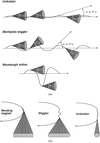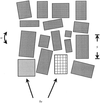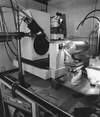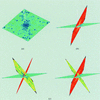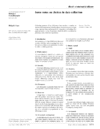issue contents
October 1999 issue
Data collection and processing
Proceedings of the CCP4 study weekend

Cover illustration: A diffraction pattern of lysozyme (p. 1703) and a surface representation of Semliki Forest virus (p. 1742).
research papers
Open  access
access
 access
accessTechniques are described for the autoindexing of X-ray diffraction oscillation patterns and for the relative scaling of a series of such patterns to form a complete three-dimensional data set.
Open  access
access
 access
accessWays of optimizing X-ray cryo-data quality and quantity are discussed. The possible advantages/disadvantages of collecting X-ray data at 30 K instead of 100 K are also considered.
Open  access
access
 access
accessKey features of the applications of the macromolecular crystallography beamlines at the ESRF are described.
Open  access
access
 access
accessProperties such as the required size, divergence, wavelength spread and intensity of the X-ray beam, together with the size and resolution of the detector, are derived from the properties of protein crystals and their diffraction patterns.
Open  access
access
 access
accessCharge-coupled device detectors are compared with other commercially available detectors and their use with home X-ray sources is discussed.
Open  access
access
 access
accessThe performance of the novel MicroSource X-ray generator is analysed and predictions are made for alternative designs of focusing optics. Relative performance of this microfocus tube and an optimized mirror system become increasingly advantageous with the study of ever-smaller crystals.
Open  access
access
 access
accessA detailed comparison of usable flux, spectral purity, divergence, beam profile and data quality for home-laboratory X-ray optics systems (total-reflection mirrors and multilayer monochromators) is presented.
Open  access
access
 access
accessA one-dimensional FFT indexing routine developed previously is discussed with particular reference to its implementation in MOSFLM. The method has been shown to be robust and reliable even for unfavourable test images.
Open  access
access
 access
accessEquations are derived for the summation integration and profile-fitted estimates of diffracted intensities and their standard errors. The advantages of profile fitting are discussed.
Open  access
access
 access
accessThe optimal strategy of collecting X-ray diffraction data from macromolecular crystals using the rotation method is discussed in both quantitative and qualitative aspects.
Open  access
access
 access
accessThe expectations and consequences of the processing of diffraction images with thick and thin rotation-angle increments are discussed. The d*TREK suite for processing images is briefly introduced.
Open  access
access
 access
accessAn outline of the steps involved in a MAD experiment are described, as well as recent experiences in ultrafast data collection.
Open  access
access
 access
accessDeconvolution of overlapped spots, careful integration of weak spots and the use of statistical analysis tools are shown to improve the data quality of monochromatic data sets. The described techniques have been implemented in the integration software PrOW.
Open  access
access
 access
accessCryo-electron microscopy cryo-EM) and crystallography are complimentary tools now available to the structural biologist. A brief discussion of the problems faced, and the advantages of cryo-Em and three-dimensional image reconstruction, along with three case studies, will be discussed.
Open  access
access
 access
accessThe detection and analysis of diffraction data from twinned macromolecular crystals is discussed, as is the recovery of useful data from these crystals.
Open  access
access
 access
accessAlthough it is better, if possible, to collect highly redundant diffraction data, the most damaging outliers can be detected using structure-factor probability distributions.
Open  access
access
 access
accessExperiments with macromolecular microcrystals at the EMBL/ESRF have shown that this technique offers several advantages. A custom-designed microdiffractometer is being built to ease microcrystal handling.
short communications
Open  access
access
 access
accessThis paper presents a series of questions which should be considered in planning a data-collection experiment.


 journal menu
journal menu











